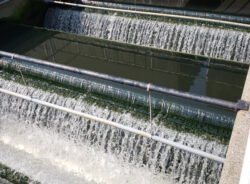
Ultrafiltration Wastewater Treatment
Ultrafiltration Wastewater Treatment: A Comprehensive Analysis
Introduction
As global populations increase and industrial activities expand, the strain on water resources becomes more significant. Wastewater treatment is vital in preserving water quality and protecting public health. Among the various treatment methods, ultrafiltration (UF) is emerging as a critical technology due to its efficiency in removing suspended solids, bacteria, and some viruses. This article will explore the mechanisms, advantages, limitations, and future prospects of ultrafiltration in wastewater treatment, offering insights that can help facility managers and environmental engineers make informed decisions.
Understanding Ultrafiltration
1. What is Ultrafiltration?
Ultrafiltration is a membrane filtration process utilizing a semi-permeable membrane with pore sizes ranging from 1 to 100 nanometers. It operates under pressure, allowing water and low molecular weight solutes to pass through while retaining larger particles, colloids, and microorganisms. This technology serves as both a standalone treatment and a complementary process to traditional treatment methods.
2. Mechanism of Ultrafiltration
The ultrafiltration process can be broken down into several key steps:
-
Pre-treatment: Before ultrafiltration, pretreatment processes, such as screening and sedimentation, are employed to remove larger particles and debris.
-
Membrane filtration: Water is forced through the UF membrane under pressure, which separates contaminants based on size and charge.
- Permeate and concentrate: The filtered water, known as permeate, is collected on the other side of the membrane, while the concentrate, containing the retained contaminants, is sent for further treatment or disposal.
3. Performance Metrics
Factors such as flux rate, recovery rate, and membrane fouling significantly influence the performance of an ultrafiltration system:
-
Flux Rate: Defined as the volume of permeate produced per unit area of membrane per time (e.g., L/m²/h). Optimizing the flux rate is crucial for efficient operation.
-
Recovery Rate: This is the percentage of influent water that is converted into permeate. Typical recovery rates for UF systems range from 70% to 90%.
- Membrane Fouling: This is a common challenge where contaminants accumulate on the membrane surface, leading to reduced performance. Strategies to mitigate fouling include employing backwashing, chemical cleaning, and optimizing operational parameters.
Advantages of Ultrafiltration in Wastewater Treatment
1. High Efficiency in Contaminant Removal
Research published in leading environmental engineering journals indicates that ultrafiltration can achieve removal rates of 99% for bacteria and 95% for viruses. This makes UF particularly valuable in treating municipal and industrial wastewater where microbial contamination is a concern.
2. Reduced Chemical Usage
Ultrafiltration minimizes the need for chemical coagulants traditionally used in coagulation and flocculation processes. A study by the American Water Works Association found that facilities employing UF reduced their chemical consumption by as much as 40%, leading to lower operational costs and reduced environmental impact.
3. Modular and Scalable
Ultrafiltration systems can be designed as modular units, allowing for scalability in treatment capacity. This flexibility is advantageous for facilities facing fluctuating influent quality or quantity.
Limitations and Challenges
1. Membrane Fouling
Despite its advantages, ultrafiltration is not without challenges. Membrane fouling can severely impact operational efficiency. According to the International Journal of Environmental Science, fouling can lead to annual maintenance costs averaging $1.25 million for large-scale facilities. This necessitates ongoing investment in maintenance and cleaning processes.
2. Initial Capital Costs
The initial investment for ultrafiltration technology can be significant, often exceeding that of traditional methods. For instance, a case study conducted in London indicates that the capital expenditure for ultrafiltration plants can be 20% to 50% higher than conventional systems.
3. Limited Removal of Dissolved Solids
While ultrafiltration is effective for suspended solids and microorganisms, its efficacy in removing dissolved solids, such as salts, is limited. Facilities treating highly saline wastewater may require additional processes like reverse osmosis.
Future Prospects
1. Technological Advancements
The future of ultrafiltration lies in technological advancements such as the development of low-fouling membranes and smart monitoring systems. Innovations in membrane materials and configurations are expected to enhance performance and reduce fouling rates.
2. Integration with Other Technologies
Combining ultrafiltration with technologies like nanofiltration and reverse osmosis can create a more robust treatment system capable of handling a wider range of contaminants. Such integrations will enable facilities to meet increasingly stringent discharge standards.
3. Regulatory Trends and Market Growth
According to recent industry analysis, the global ultrafiltration market for wastewater treatment is expected to grow at a CAGR of 8.5% from 2022 to 2032. This growth is driven by stricter environmental regulations and a growing emphasis on sustainable water management practices.
Conclusion
Ultrafiltration represents a transformative technology in wastewater treatment, offering high efficiency, reduced chemical usage, and scalability. However, challenges related to membrane fouling and capital costs necessitate careful consideration and planning. Through advancements in technology and effective integration with complementary processes, ultrafiltration has the potential to play an even more significant role in creating sustainable water management solutions. As facility managers and environmental engineers face increasing pressure to meet regulatory standards and public expectations, ultrafiltration stands out as a viable option that merits serious consideration.
Frequently Asked Questions
What types of wastewater can ultrafiltration treat?
Ultrafiltration can effectively treat municipal wastewater, industrial effluents, and even some agricultural runoff. Its effectiveness, however, may vary depending on the composition and characteristics of the influent.
How does ultrafiltration compare to reverse osmosis?
While both are membrane filtration processes, reverse osmosis removes smaller particles and dissolved solids, whereas ultrafiltration focuses on larger suspended solids and microorganisms. Depending on treatment objectives, they can be used in tandem for enhanced results.
What is the expected lifespan of ultrafiltration membranes?
Typically, UF membranes have a lifespan ranging from 5 to 10 years, depending on the quality of influent water, operating conditions, and maintenance practices.
By addressing these aspects, ultrafiltration wastewater treatment not only underscores its importance in the current and future water landscape but also enhances operational efficiencies, meeting both environmental and economic imperatives.
